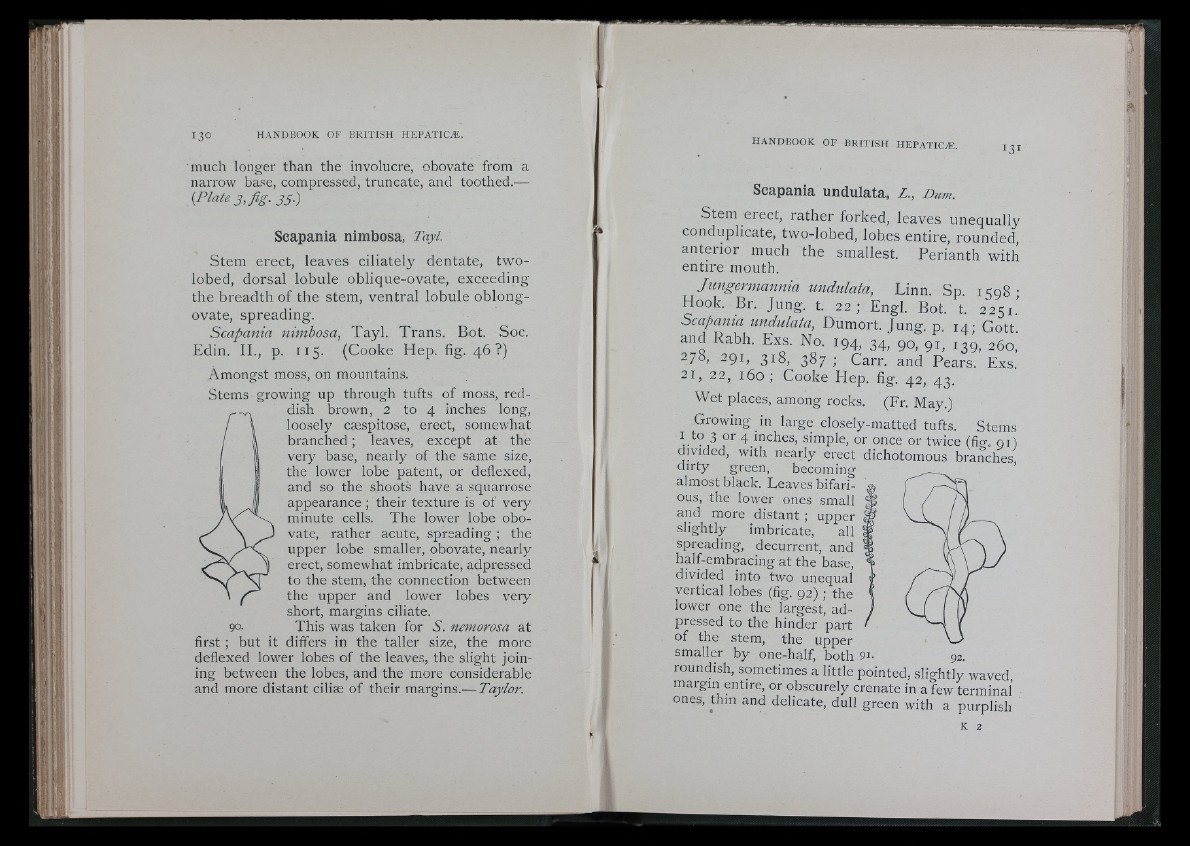
much longer than the involucre, obovate from a
narrow base, compressed, truncate, and toothed.—
{Plate 3, fig. 35.)
Scapania nimbosa, Tayl.
Stem erect, leaves ciliately dentate, two-
lobed, dorsal lobule oblique-ovate, exceeding
the breadth of the stem, ventral lobule oblong-
ovate, spreading.
Scapania nimbosa, T a y l . Trans. Bot. Soc.
Edin. I I ., p. r i5 . (Cooke Hep. fig. 4 6 ? )
Amongst moss, on mountains.
Stems growing up through tufts of moss, reddish
brown, 2 to 4 inches long,
loosely cæspitose, erect, somewhat
branched ; leaves, except at the
very base, nearly of the same size,
the lower lobe patent, or de.flexed,
and so the shoots have a squarrose
appearance ; their texture is of very
minute cells. The lower lobe obovate,
rather acute, spreading ; the
upper lobe smaller, obovate, nearly
erect, somewhat imbricate, adpressed
to the stem, the connection between
the upper and lower lobes very
short, margins ciliate.
This was taken for Z. nemorosa at
90-
first ; but it differs in the taller size, the more
deflexed lower lobes of the leaves, the slight joining
between the lobes, and the more considerable
and more distant ciliæ of their margins.— Taylor.
Scapania undulata, Z., Dum.
Stem erect, rather forked, leaves unequally
conduplicate, two-lobed, lobes entire, rounded,
anterior much the smallest. Per ianth with
entire mouth.
Jungermannia undulata, Linn. Sp. 1598 -
Hook. Br. Jung. t. 2 2 ; Engl. Bot. t. 2251.’
Scapania undulata, Dumort. Jung. p. 14; Gott.
and Rabh. Exs. No. 194, 34, 90, 91, 139^ 260,
278, 291, 318, 387 ; Carr, and Pears. Exs.
21, 22, 1 6 0 ; Co o ke Hep. fig. 42, 43.
Wet places, among rocks. (Fr. May.)
Growing in large closely-matted tufts. Stems
I to 3 or 4 inches, simple, or once or twice (fig. oi)
divided, with nearly erect dichotomous branches
dirty green, becoming
almost black. Leaves bifarious,
the lower ones small
and more dis tant ; upper 1
slightly imbricate, all '
spreading, decurrent, and
half-embracing at the base,
divided into two unequal
vertical lobes (fig. 92) ; the
lower one the largest, adpressed
to the hinder part
of the stem, the upper
smaller by one-half, both 9i- 92.
roundish, sometimes a little pointed, slightly waved
margin entire, or obscurely crenate in a few terminal
ones, thin and delicate, dull green with a purplish